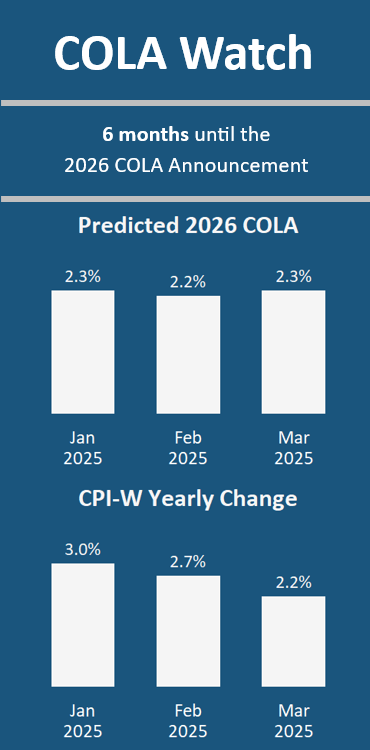For Immediate Release – April 10, 2025
After Tariff Announcement and Pause, Predicted 2026 COLA Rises to 2.3%
When the Trump administration announced sweeping new tariffs on imports on April 2nd, the stock market retreated. The Dow Jones Industrial Average fell 5.5 percent, and the Nasdaq fell 5.8 percent. Less than a week later, the administration paused the tariffs for most countries for 90 days while further raising them on China.
This news hasn’t had a major effect on TSCL’s COLA prediction for 2026. Our model’s prediction this month is 2.3 percent, which is 0.1 percentage points higher than last month’s prediction and 0.2 percentage points lower than the last COLA of 2.5 percent.
Many economists predict that tariffs would drive increased inflation. While this would increase the COLA, it would also put seniors under financial pressure as prices rise—like we’ve already seen with essentials like eggs.
TSCL calls on President Trump to provide exemptions on critical products for seniors. If the administration does un-pause the tariffs, exceptions for drugs, medical equipment, and essential food items could soften the blow for seniors.
Key Insights:
- While President Trump and his advisors believe that his tariffs will result in billions of dollars of new revenue for the government, many top economic analysts disagree. They believe the tariffs will amount to a new tax that U.S. consumers will have to pay for goods and services they depend on for their everyday needs. Former Vice President Mike Pence has referred to the tariffs as the largest tax increase in U.S. history.
- The tariffs have the potential to drive increased drug prices for seniors. The Journal of the American Medical Association has estimated that the import taxes could affect as many as 400 drug products from Canada alone. The U.S. also imports far more drug products from China, India, and Mexico, each of which has been targeted for higher import taxes.
- TSCL’s COLA model will capture tariff-driven inflation in the coming months. One key indicator for the TSCL COLA prediction is the Consumer Price Index for Urban Wage Earners (CPI-W), which the Social Security Administration uses to calculate the COLA. Since the CPI-W update announced this month captures inflation for March, we’re likely to start seeing the effects of the tariffs in next month’s announcement, which will feature data for April.
TSCL Executive Director Shannon Benton says…
- “Placing broad-based tariffs on goods from numerous countries could have a profoundly negative impact on the daily lives of seniors, including the costs of drugs and medical equipment that many seniors rely on. It is also highly likely that import taxes will keep food prices high, increase auto insurance costs, and contribute to higher inflation, among other effects.”
- “While TSCL supports President Trump’s goals of returning manufacturing and strategic production to American shores, we can’t accept the short-term consequences for seniors. We call on the administration to immediately make exceptions to the tariffs for drugs, medical equipment, and essential everyday goods that many seniors already struggle to afford.”
- “Along with most economists, TSCL expects the new tariffs to lead to higher inflation. Our COLA model will likely reflect that in coming months as the CPI-W and other economic indicators respond to the new import tax policies.”
About TSCL:
The Senior Citizen’s League (TSCL) is one of the nation’s largest nonpartisan seniors’ groups. Established in 1992 as a special project of The Retired Enlisted Association, our mission is to promote and assist our members and supporters, educate and alert senior citizens about their rights and freedoms as U.S. citizens, and protect and defend the benefits seniors have earned and paid for. TSCL consists of vocally active senior citizens concerned about the protection of their Social Security, Medicare, and veteran or military retiree benefits. To learn more, visit https://seniorsleague.org/about-us/.
About the TSCL COLA Model:
TSCL issues a new prediction of the next COLA for Social Security each month using our statistical model. The model incorporates the Consumer Price Index, the Federal Reserve interest rate, and the national unemployment rate to make its predictions. The model’s predictions update throughout the year, adjusting in response to economic conditions. For additional information about the model, contact Alex Moore, TSCL’s statistician, at amoore@tsclhq.org.
We released a new version of the model, v1.2, in January 2025. The new version updates the model’s use of dates, processing data according to the federal fiscal year instead of the calendar year. The new model also reduces each prediction’s reliance on previous predictions made throughout the federal fiscal year.
Contact Information:
- Shannon Benton, Executive Director: sbenton@tsclhq.org; 703-548-5568
- Alex Moore, Statistician: amoore@tsclhq.org; 571-374-2658


